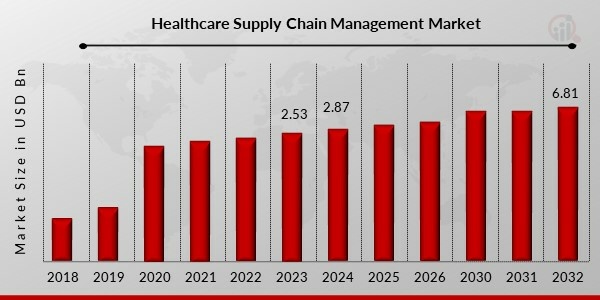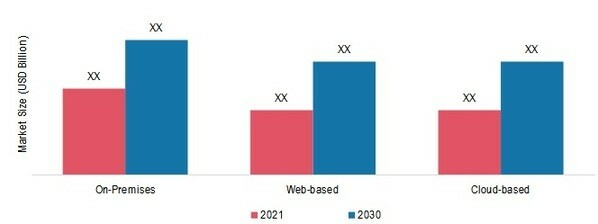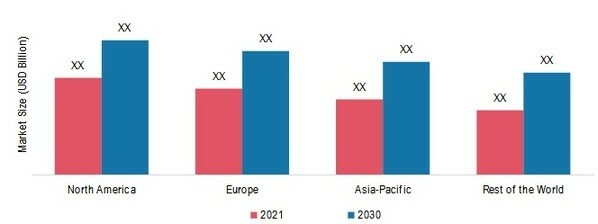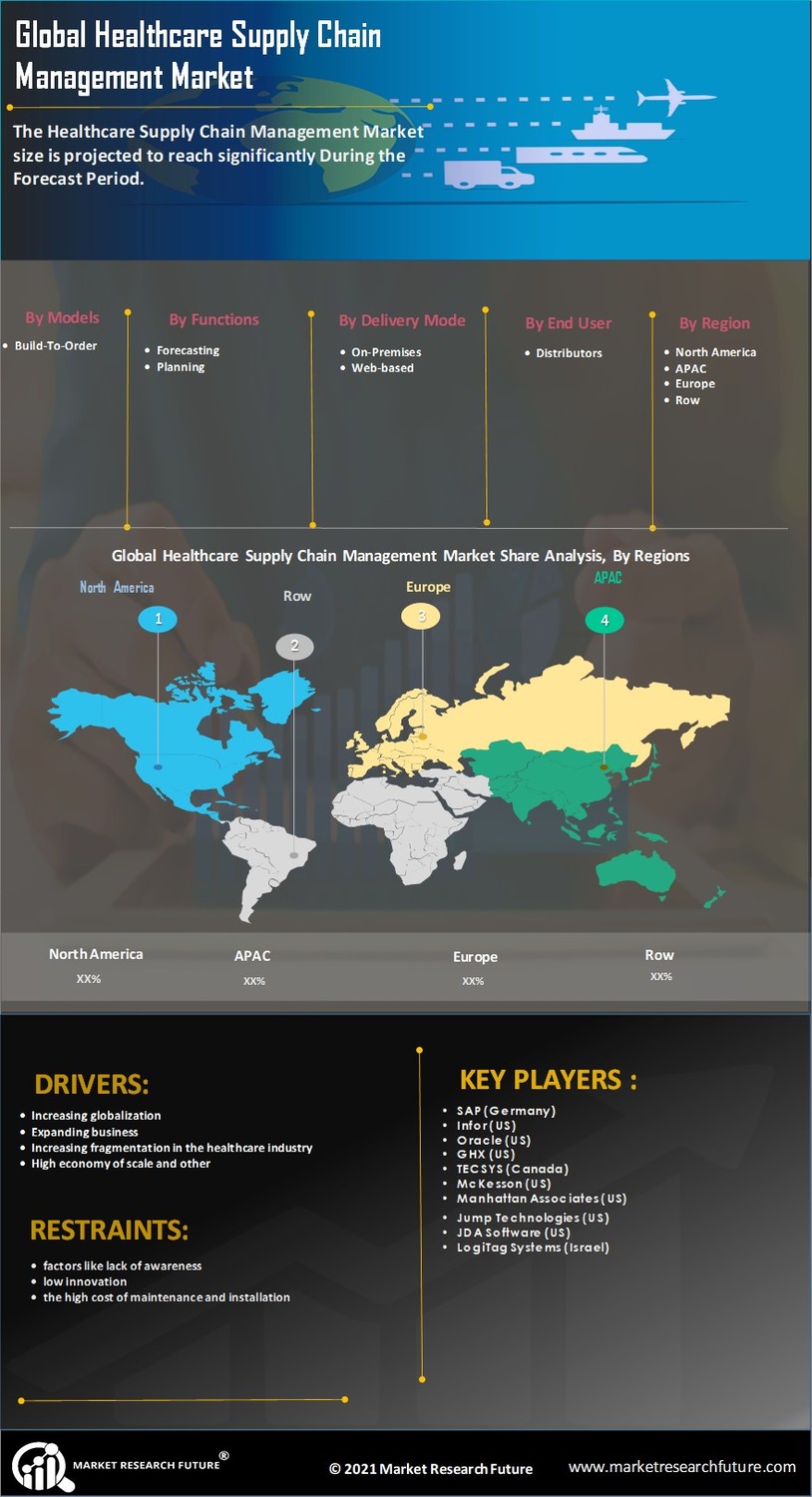Healthcare Supply Chain Management Market Summary
As per Market Research Future Analysis, the Healthcare Supply Chain Management Market was valued at USD 2.53 billion in 2023 and is projected to reach USD 6.81 billion by 2032, growing at a CAGR of 14.80% from 2024 to 2032. The market is driven by the increasing adoption of Radio Frequency Identification (RFID) technology and innovative supply chain solutions, particularly in tracking pharmaceuticals. The COVID-19 pandemic has highlighted the need for efficient supply chain management, leading to increased investments in technology and software solutions. Key players are focusing on enhancing productivity and reducing costs through advanced inventory management systems.
Key Market Trends & Highlights
The market is witnessing significant trends that are shaping its growth trajectory.
- Healthcare Supply Chain Management Market Size in 2023: USD 2.53 billion.
- Projected Market Size by 2032: USD 6.81 billion.
- CAGR during 2024-2032: 14.80%.
- Majority share in 2021 held by Build-to-Order segment.
Market Size & Forecast
2023 Market Size: USD 2.53 billion
2024 Market Size: USD 2.87 billion
2032 Market Size: USD 6.81 billion
CAGR (2024-2032): 14.80%
Largest Regional Market Share in 2021: North America.
Major Players
Key players include SAP, Infor, GHX, TECSYS, McKesson, Manhattan Associates, Jump Technologies, JDA Software, LogiTag Systems, and Oracle.

The COVID-19 pandemic has disrupted global supply chains in an unprecedented manner as indicated by an article published in Elsevier Public Health Emergency Collection in March 2022. There were increased gaps between supply and demand following the pandemic. The research market is expected to grow during the forecast period because some companies are now developing innovative supply chain management solutions for tracking pharmaceuticals in the healthcare sector.
Saudi Pharmaceutical Journal published an article in November 2022, which explains that inventory and supply chain management's primary focus is on enhancing productivity, cutting costs, and getting the necessary supplies when required for better patient care.
Tageos, a company headquartered in France, unveiled its EOS-202 U9 RAIN RFID Inlay for healthcare and pharmaceutical applications August 2021.
In January 2022, QR code AR-powered drug packs without paper access to drug-related information have been introduced by UAE Ministry of Health. It is therefore possible for patients to read about a medicine just by scanning a QR code on the package.
During October 2022, Methodist Hospitals based in Indiana partnered with cloud service provider Infor to establish a cloud-based healthcare application enabling the health system to standardize critical processes such as finance, HR, logistics and operations among others.
Jump Technologies released its cloud-based software solution named JumpStock May 2022. It links to EMR/EHR, ERP or scheduling systems as well as it improves compliance with lot control (date codes). This means that hospitals can reduce costs from stock hoarding, physician preference variances, and stockouts via expiration dating products used within hospital settings.; thereby saving hospitals money on items like supply hoarding or stockouts.
Accord BioPharma Intas Pharmaceuticals' United States specialty division launched a mobile app along with web-based inventory management capabilities in January 2023, known as AccordConnects, to help doctors track their inventory of Accord BioPharma's therapies.
A national provider of healthcare inventory control and end-to-end supply chain management software/services and a GHX subsidiary, Syft launched Syft Synergy 4.5 in June 2022. The UI mobile app on this supply chain management software now makes it easy to receive and send out supplies.
Healthcare Supply Chain Management Market Trends
Growing Adoption of Radio Frequency Identification (RFID) to Boost Market Growth
Radio Frequency Identification (RFID) technology has been in existence for several years now, however, advances in the technology can potentially help many companies to improve their supply chain operations. In healthcare organizations, RFID tags can be used to track and manage pharmaceuticals. The system provides notifications to the user regarding expiration dates and the stock level of medication.
Furthermore, it also helps in tracking machines, equipment, and vehicles, which are critical for any organization by providing their location, thus helping in asset management and maintenance. Real-time tracking of healthcare products provides major opportunities and helps them improve customer services such as increasing the efficiency of hospital processes and reducing wastes such as expired products, surplus inventory, and unnecessary staff movements. Therefore, the adoption of RFID tags in healthcare supply chain management has increased rapidly due to its adoption in tagging pharmaceutical products, such as prescription drugs and other medical devices, thereby leading to improvement in stock control.
Healthcare Supply Chain Management Market Segment Insights
Healthcare Supply Chain Management Models Insights
The healthcare supply chain management market segmentation, based on model, includes make-to-stock model, build-to-order, continuous replenishment model, chain assembly, and others. The build-to-order segment held the majority share in 2021 in respect to the healthcare supply chain management revenue. This is primarily owing to the growing self-sufficient healthcare ecosystem, emergence of cloud-based solutions, and growing number of unique device identification (UDI). Growing pressure on healthcare providers to increase efficiency while reducing cost is encouraging the adoption of healthcare supply chain management solutions around the world.
Healthcare supply chain management also includes efficient supply chain methods to achieve traceability and operational efficiency while reducing operating costs without compromising quality.
August 2022: Kit Check collaborated with Genixus to introduce its RFID technology in Genixus’s new KinetiX syringes. This collaboration states that RFID-tagged will be provided for Genixus’s KinetiX
October 2022:Tecsys Inc. launched Elite Healthcare Receiving, it is an extension to its end-to-end Elite Healthcare Supply Chain execution platform. This will allow for coordinated distribution to easily manage items in all locations throughout the hospital using a single point of entry. Additionally, this will also help to eliminate the use of multiple tools, systems, and processes and provides you with a complete chain of custody tracking.
Healthcare Supply Chain Management Function Insights
The healthcare supply chain management market segmentation, based on function, includes forecasting and planning, inventory management and procurement, internal logistics and operations, warehousing and distribution, reverse and extended logistics, and others. The forecasting and planning segment dominated the market in 2021 during the forecast period, 2024-2032. This is due to the growing preference for efficient planning, visibility into consigned inventory, and growing demand for limiting the large-scale counterfeiting of drugs in the pharmaceutical industry. Therefore, rising applications of healthcare supply chain management implants positively impacts the market growth.
Healthcare Supply Chain Management Component Insights
The healthcare supply chain management market data based on component, includes software, hardware, and services. The software component segment dominated the market in 2021 during the forecast period, 2024-2032. The growing adoption of software such as SaaS that offers next-generation cloud computing applications such as supply chain management enterprise resource planning are among key factors boosting the market growth. The rising need for efficient management of organizational workflows in healthcare organizations and a shift in the trend toward value-based care in developed economies are boosting segment growth.
Furthermore, rising initiatives undertaken by private and public players for supporting healthcare IT infrastructure are driving the segment in healthcare organizations.
February 2020: ProShip, Inc. collaborated with JDA Software Inc. to expand its portfolio of integrated shipping and supply chain operations along with collaborating for some of their complicated and largest installs. This collaboration has further broadened the growth opportunity for the healthcare supply chain management industry.
April 2021: Tecsys Inc. announced that Spectrum Health has upgraded its Tecsys environment to accommodate its growing network of supply chain and warehousing demands. The new system includes a SaaS supply chain management platform with warehouse management, distribution management, and delivery management, with robust connectors to Spectrum Health's Workday ERP.
Healthcare Supply Chain Management Delivery Mode Insights
The healthcare supply chain management market data based on delivery mode, includes on-premises, web-based, and cloud-based. The cloud-based delivery mode segment dominated the market in 2021 during the forecast period, 2024-2032. This is attributed to the associated advantages such as identification, monitoring, and mitigation of supply chain risks, disruptions, and vulnerabilities. A shift in the trend towards value-based care in developed countries, coupled with the upsurge in the need for efficient management of structural workflows in healthcare companies, are a few factors propelling the segment's growth.
Furthermore, the platform also helps to enable collaborative information sharing, growing launches by companies helps in the growth of the healthcare supply chain management market.
February 2022: Healthcare Exchange, LLC. acquired Syft, a provider of AI-enhanced inventory control and end-to-end supply chain management. This acquisition helped the company to expand its existing portfolio for healthcare supply chain management solutions
August 2019: Pfizer and Biogen-led organization Clinical Supply Blockchain Working Group (CSBWG) completed a proof of concept project for a digital inventory and event tracking record in the pharmaceutical & clinical supply chain.
Figure 2: Healthcare Supply Chain Management Market, by Delivery Mode, 2023 & 2032 (USD Billion)
Source: Secondary Research, Primary Research, Market Research Future Database and Analyst Review
Healthcare Supply Chain Management End-User Insights
The healthcare supply chain management market data based on end-user, includes healthcare providers, healthcare manufacturers, distributors, and others. The healthcare manufacturers dominated the market in 2021 during the forecast period, 2024-2032. This is attributed to the growing adoption of SaaS software among healthcare manufacturers is changing the trend by shifting from paper-based functioning to an automated system. Pharmaceutical companies are among the major beneficiaries of emerging IT trends and technologies including cloud computing.
This has also reduced the risk of errors and help to overcome substantial challenges such as efficient planning and visibility into consigned inventory. Furthermore, the pharmaceutical industry generates petabytes of data every second through multiple data streams such as R&D and CRM systems helps in the growth of the healthcare supply chain management market.
March 2022: Symplr, the leader in enterprise healthcare operations, and Charlesbank Capital Group, L.P. entered into a stretegic agreement to purchase GreenLight Medical, Inc., a provider of healthcare supply chain management software. This will creates a comprehensive cloud-based software platform for value-based purchasing decision support, enabling healthcare organizations to make timely and data-driven decisions.
March 2020: Jump Technologies temporarily opened its inventory management solutions for all healthcare facilities. Such initiatives were focused on helping hospitals to maintain their supplies during the pandemic.
Healthcare Supply Chain Management Regional Insights
By Region, the study segments the market into North America, Europe, Asia-Pacific and Rest of the World. North America healthcare supply chain management held the largest market share in 2021 This is attributed to the increasing prevalence of chronic diseases, regulatory requirements, mandatory implementation of GS1 standards and Unique Device Identifiers (UDIs) on pharmaceutical drugs and medical devices across the region.
Further, the major countries studied are: The U.S, Canada, Germany, France, UK, Italy, Spain, China, Japan, India, Australia, South Korea, and Brazil.
Figure 3: HEALTHCARE SUPPLY CHAIN MANAGEMENT MARKET SHARE BY REGION 2023 (%)
Source: Secondary Research, Primary Research, Market Research Future Database and Analyst Review
Europe healthcare supply chain management market accounts for the second-largest market share due to the increasing awareness of suppliers of the demand for healthcare supply chain management solutions. Further, the Germany healthcare supply chain management market held the largest market share, and the UK healthcare supply chain management market was the fastest growing market in the European region.
The Asia-Pacific Healthcare Supply Chain Management Market is expected to grow with the significant share. This is due to constantly developing healthcare IT infrastructure and growing demand for cloud computing are some of the factors accelerating growth. Moreover, China healthcare supply chain management market held the largest market share, and the India healthcare supply chain management market was the fastest growing market in the Asia-Pacific region.
For instance, India healthcare supply chain management market is the favored destination for growing adoption of GS1 standards to track the visibility of pharmaceutical products to further boost the market growth in the Asia-Pacific region. According to the World Health Organization (WHO), Asia Pacific holds the largest share of the trade in counterfeit medicines. The pharmaceutical industry has adopted scanning technologies, such as RFID and barcodes, to track products and gain information about products for curbing the counterfeiting of drugs. Hence, Asia-Pacific is anticipated to register the highest growth rate over the forecast period from 2024–2032.
Healthcare Supply Chain Management Key Market Players & Competitive Insights
Major market players are spending a lot of money on R&D to increase their product lines, which will help the healthcare supply chain management market grow even more. Market participants are also taking a range of strategic initiatives to grow their worldwide footprint, including new product launches, contractual agreements, mergers and acquisitions, increased investments, and collaboration with other organizations. Competitors in the healthcare supply chain management industry must offer cost-effective items to expand and survive in an increasingly competitive and rising market environment.
One of the primary business strategies adopted by manufacturers in the healthcare supply chain management industry to benefit clients and expand the healthcare supply chain management market sector is to manufacture locally to reduce operating costs. In recent years, healthcare supply chain management has provided advance technologies with some of the most significant benefits.
e2open (US), a leading network-based provider of cloud-based, mission-critical, end-to-end supply chain management software. In August 2021, e2open announced a strategic partnership with Vizient, Inc. the largest healthcare performance improvement company in the US to facilitate the rapid development of a cloud-based, multi-party collaboration platform that enables end-to-end visibility between participating healthcare providers, distributors, and suppliers. This agreement will create a platform that improves collaboration between participating healthcare organizations and suppliers.
Key Companies in the Healthcare Supply Chain Management Market Includes
- SAP (Germany)
- Infor (US)
- GHX (US)
- TECSYS (Canada)
- McKesson (US)
- Manhattan Associates (US)
- Jump Technologies (US)
- JDA Software (US)
- LogiTag Systems (Israel)
- Oracle (US)
- Advocate Health Care (Murray UT)
Healthcare Supply Chain Management Industry Developments
October 2020: Sandoz Inc. launched its Radio Frequency Identification (RFID) tagged critical injectable medicines with Kit Check to optimize the supply chain and automate restocking in US hospitals. Sandoz and Kit Check together to provide comprehensive solutions to hospital customers to lower costs, reduce risks and treat patients safely and more efficiently
June 2020: Vamstar, that connects healthcare buyers and suppliers using artificial intelligence, got project funding of USD 55.5 million from Innovate UK, the innovation agency, which is also part a of UK government's fast-track funding to drive forward cutting-edge start-ups in response to the coronavirus crisis and to enhance hospital supply management
May 2020: Oracle collaborated with KPMG to launch new solutions in the healthcare industry enabling its clients to move their finance, supply chain, and human resources functions to the Oracle cloud
Healthcare Supply Chain Management Market Segmentation
Healthcare Supply Chain Management Models Outlook
- Make-To-Stock Model
- Build-To-Order
- Continuous Replenishment Model
- Chain Assembly
- Others
Healthcare Supply Chain Management Function Outlook
- Forecasting and Planning
- Inventory Management and Procurement
- Internal Logistics and Operations
- Warehousing and Distribution
- Reverse and Extended logistics
- Others
Healthcare Supply Chain Management Component Outlook
Healthcare Supply Chain Management Delivery Mode Outlook
- On-Premises
- Web-based
- Cloud-based
Healthcare Supply Chain Management End User Outlook
- Healthcare Providers
- Healthcare Manufacturers
- Distributors
- others
Healthcare Supply Chain Management Regional Outlook
| Report Attribute/Metric |
Details |
| Market Size 2023 |
USD 2.53 billion |
| Market Size 2024 |
USD 2.87 billion |
| Market Size 2032 |
USD 6.81 billion |
| Compound Annual Growth Rate (CAGR) |
14.80% (2024-2032) |
| Base Year |
2023 |
| Forecast Period |
2024-2032 |
| Historical Data |
2018 & 2020 |
| Forecast Units |
Value (USD Billion) |
| Report Coverage |
Revenue Forecast, Competitive Landscape, Growth Factors, and Trends |
| Segments Covered |
Models, Function, Component, Delivery Mode, End-User and Region |
| Geographies Covered |
North America, Europe, Asia Pacific, and Rest of the World |
| Countries Covered |
The U.S, Canada, Germany, France, UK, Italy, Spain, China, Japan, India, Australia, South Korea, and Brazil |
| Key Companies Profiled |
SAP (Germany), Infor (US), Oracle (US), GHX (US), TECSYS (Canada), McKesson (US), Manhattan Associates (US), Jump Technologies (US), JDA Software (US), LogiTag Systems (Israel), Advocate Health Care (Murray UT) |
| Key Market Opportunities |
Growing number of unique device identification (UDI) |
| Key Market Dynamics |
Growing adoption of Radio Frequency Identification (RFID) Expanding acceptance of supply chain management solutions |
Healthcare Supply Chain Management Market Highlights:
Frequently Asked Questions (FAQ):
The healthcare supply chain management market is anticipated to reach USD 6.81 billion at a CAGR of 14.80% during the forecast period of 2024 to 2032
The US healthcare supply chain management market share is 35-40% during the forecast period of 2024 to 2032
The healthcare supply chain management market is expected to register a CAGR of 14.80% during the forecast period of 2024 to 2032.
The North America held the largest market share in the healthcare supply chain management market
SAP (Germany), Infor (US), Oracle (US), GHX (US), and TECSYS (Canada) are the key players in the healthcare supply chain management market
The software component led the healthcare supply chain management market
The healthcare manufacturers segment held the healthcare supply chain management market


















